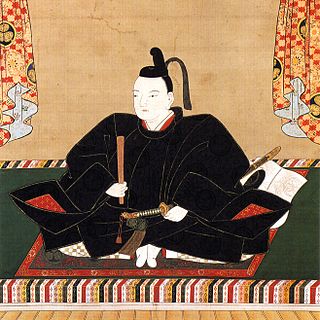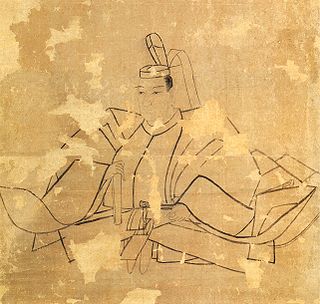
Arai Hakuseki was a Confucianist, scholar-bureaucrat, academic, administrator, writer and politician in Japan during the middle of the Edo period, who advised the shōgun Tokugawa Ienobu. His personal name was Kinmi or Kimiyoshi (君美). Hakuseki (白石) was his pen name. His father was a Kururi han samurai Arai Masazumi.

Tokugawa Tsunayoshi was the fifth shōgun of the Tokugawa dynasty of Japan. He was the younger brother of Tokugawa Ietsuna, as well as the son of Tokugawa Iemitsu, the grandson of Tokugawa Hidetada, and the great-grandson of Tokugawa Ieyasu.

Tokugawa Ietsugu; 徳川 家継 was the seventh shōgun of the Tokugawa dynasty, who ruled from 1713 until his death in 1716. He was the son of Tokugawa Ienobu, thus making him the grandson of Tokugawa Tsunashige, daimyō of Kofu, great-grandson of Tokugawa Iemitsu, great-great grandson of Tokugawa Hidetada, and finally the great-great-great grandson of Tokugawa Ieyasu.

Tokugawa Ieharu (徳川家治) was the tenth shōgun of the Tokugawa shogunate of Japan, who held office from 1760 to 1786.

Tokugawa Ietsuna was the fourth shōgun of the Tokugawa dynasty of Japan who was in office from 1651 to 1680. He is considered the eldest son of Tokugawa Iemitsu, which makes him the grandson of Tokugawa Hidetada and the great-grandson of Tokugawa Ieyasu.

Kansei (寛政) was a Japanese era name after Tenmei and before Kyōwa. This period spanned the years from January 1789 through February 1801. The reigning emperor was Kōkaku-tennō (光格天皇).

Tenmei (天明) is a Japanese era name for the years between the An'ei Era and before the Kansei Era, from April 1781 through January 1789. The reigning emperor was Kōkaku Tennō' (光格天皇).

Shōtoku (正徳) was a Japanese era name after Hōei and before Kyōhō. This period spanned the years from April 1711 through June 1716. The reigning emperor was Nakamikado-tennō (中御門天皇).

Tenna (天和) was a Japanese era name after Enpō and before Jōkyō. This period spanned the years from September 1681 through February 1684. The reigning emperor was Reigen-tennō (霊元天皇).

Enpō (延宝) is the Japanese era name after Kanbun and before Tenna. This period spanned the years from September 1673 to September 1681. The reigning emperor was Reigen-tennō (霊元天皇).

Manji (万治) was a Japanese era name after Meireki and before Kanbun. This period spanned the years from July 1658 through April 1661. The reigning emperor was Go-Sai-tennō (後西天皇).

Itakura Katsushige was a Japanese daimyō of the Azuchi–Momoyama Period to early Edo period. He fought at the side of Tokugawa Ieyasu at the Battle of Sekigahara in 1600. He was also an ordained Shin Buddhist priest.

Nagasaki bugyō (長崎奉行) were officials of the Tokugawa shogunate in Edo period Japan. Appointments to this prominent office were usually fudaidaimyōs, but this was amongst the senior administrative posts open to those who were not daimyōs. Conventional interpretations have construed these Japanese titles as "commissioner", "overseer" or "governor".

Toki Yoritoshi was a Japanese daimyō of the Edo period. He served in a variety of positions in the Tokugawa shogunate, including Kyoto Shoshidai (1734–1732) and rōjū.
Kuze Hirotami (久世広民) (1737–1800), also known as Kuze Tango-no-kami Hirotami (久世丹後守広民), was a Japanese politician during late 18th-century Nagasaki bugyō or governor of Nagasaki port, located on southwestern shore of Kyūshū island in the Japanese archipelago. Kuze was one of the Nagasaki bugyō between 1775 and 1784. His childhood name was Shōkurō (称九郎). His only daughter married Uesugi Yoshinaga.
Inaba Masanobu was a daimyō in early 19th-century Japan during the Edo period. Masanobu's family was descended from Masanari, a younger son of Konō Michitaka, daimyō from Mino province who had been a vassal of Oda Nobunaga and later Toyotomi Hideyoshi. Thunberg's trip from Dejima to Edo passed through Yamashiro, and his account reports that Masanobu was daimyō of Yodo.
Sakuji-bugyō (作事奉行) were officials of the Tokugawa shogunate having responsibility for architecture and construction matters.
Osaka machi-bugyō were officials of the Tokugawa shogunate in Edo period Japan. Appointments to this prominent office were usually fudai daimyō, but this was amongst the senior administrative posts open to those who were not daimyō. Conventional interpretations have construed these Japanese titles as "commissioner" or "overseer" or "governor".
Edo machi-bugyō (江戸町奉行) were magistrates or municipal administrators with responsibility for governing and maintaining order in the shogunal city of Edo. Machi-bugyō were samurai officials of the Tokugawa shogunate in Edo period Japan. Appointments to this prominent office were usually hatamoto, this was amongst the senior administrative posts open to those who were not daimyōs. Conventional interpretations have construed these Japanese titles as "commissioner", "overseer" or "governor."
Matsudaira Tadachika was a Japanese fudai daimyō of the Edo period. He was highly influential in the Tokugawa shogunate under Shōgun Ieshige.








